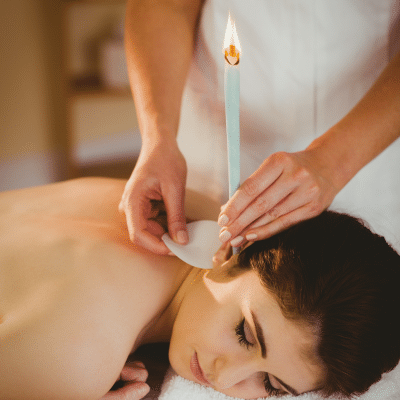Ear candles are an alternative method for removing earwax, but this home remedy is not recommended. Candles have not been shown to be effective at clearing the ears and cause risk to the ear canal.
What are Ear Candles used for?
Ear wax candles are hollow cone shaped candles that are placed inside the ear and lit. The suction of the candle is believed to draw out excess earwax and debris from the ear canal, capturing it in the hollow inside of the candle. This is supposed to improve ear health as well as treating conditions like colds and sinus infections. Ear candles have emerged as a popular at-home remedy for people experiencing the symptoms of blocked ears.

Do Ear Candles Work?
Ear candles can be extremely dangerous and are not recommended by experts in ear health. Numerous studies have found no scientific evidence that the candles pull debris from the ear. In some instances, they even found an increase in wax as a result of candle wax deposits.
There are several reasons why you should avoid using ear candles to alleviate the symptoms of excess and impacted earwax.
They Can Cause Further Blockage
Whilst you may be using an ear candle to help with blocked ears, they can often make the problem worse. Sticking any object into your ear should be avoided wherever possible. Placing ear wax candles into the ear canal, especially at a depth to hold it upright, can push earwax further down the ear canal. This could cause increased blockage, worsening symptoms of pain and discomfort.
They Can Damage the Ear Drum
Beyond causing further blockage, inserting a narrow candle into the ear canal can risk damaging the eardrum. A ruptured or perforated eardrum can result in hearing loss and increased susceptibility to infection.
They Can Cause Burns
The face and ears are extremely sensitive areas of the body and are hence very susceptible to burns. Ear candles can cause burns due to hot candle wax dripping down the candle and failing to be caught by the protective plate, which is not medical grade. These plates are often made of flimsy foil or cardboard, which is not a reliable means for catching hot wax.
They are Unsafe for Children
Ear wax candles should never be used on children as the risks increase greatly. Children’s ear canals are smaller than an adults and are therefore more prone to blockages caused by forcing a candle inside. Additionally, children will often move around during the procedure, increasing the risk of injury via dripping wax or burns.
What Methods Should You Use Instead of Ear Candles?
If you are seeking a home remedy for removing earwax, refrain from using ear wax candles and instead use ear wax softening drops. While these can only be used if there is no damage to the eardrum, they are a far safer alternative to ear candles. These drops are non-invasive and work to soften and break down the built-up wax. Softening drops can be found at your local chemist.
Make an Appointment Today
You can make an appointment at one of our clinics online. Visit our clinics tab for information on clinic locations and contact details.
For more information click here to view or download the Earworx brochure
